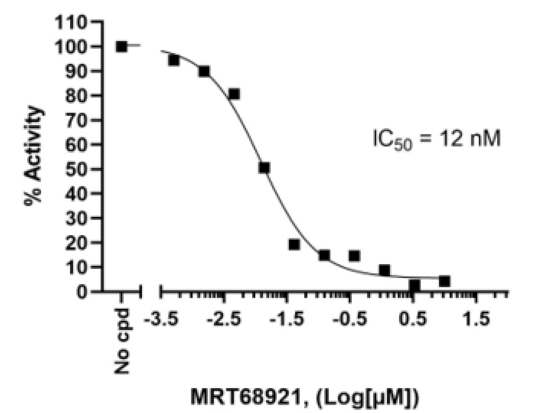ULK1 Kinase Assay Kit
The ULK1 Kinase Assay Kit is designed to measure ULK1 activity for screening and profiling applications, using Kinase-Glo® MAX as a detection reagent. The ULK1 Assay Kit comes in a convenient 96-well format, with enough purified ULK1, MBP substrate, ATP, and kinase assay buffer for 96 enzyme reactions.
- Kinase-Glo MAX (Promega, #V6071)
- Microplate reader capable of reading luminescence
- Adjustable micropipettor and sterile tips
- 30°C incubator
| Catalog # | Name | Amount | Storage |
| 40099 | ULK1* | 20 µg | -80°C |
| 79334 | Kinase Buffer 1 (5X) | 1.5 ml | -20°C |
| 79686 | ATP (500 µM) | 100 µl | -20°C |
| 78514 | Myelin basic protein (MBP), 5 mg/ml | 200 µl | -20°C |
| 79696 | 96-well plate, white | 1 | Room Temp |
*The concentration of the protein is lot-specific and will be indicated on the tube.
ULK1 (unc-51 like autophagy activating kinase 1) is a serine/threonine protein kinase that plays a critical role during the initial stages of autophagy in response to nutrient starvation. The conserved C-terminal domain of ULK1 controls the function and the localization of the protein. Knockdown of ULK1 inhibits the autophagic response and prevents rapamycin-induced autophagy, consistent with a role downstream of mTOR. ULK1 forms a complex with FIP200 and ATG13 and this complex is essential for starvation-induced autophagy (1). Both FIP200 and ATG13 are critical for correct localization of ULK1 to the pre-autophagosome and stability of the ULK1 protein (2). ULK1 is phosphorylated upon activation of the mTOR pathway in a nutrient starvation-regulated manner. Alterations in ULK signaling pathways may be involved in the formation of autophagy-regulated Lewi bodies, which have been associated with Parkinson’s disease (3).


